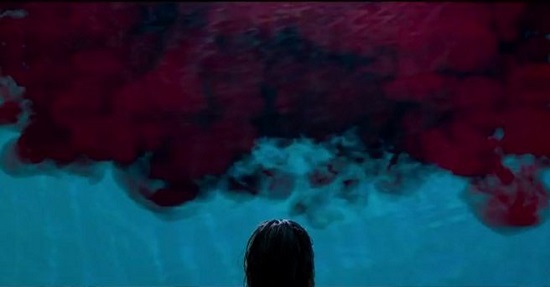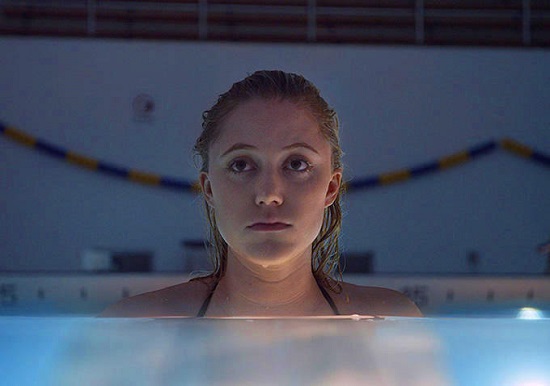Out in UK cinemas today, director David Robert Mitchell’s It Follows is already being hailed as one of the most arresting horror films in years, thanks to its dreamlike setting, naturalistic performances and inescapable sense of dread. Following an innocent sexual encounter, Jay (Maika Monroe), a 19-year-old living in a suburb of white fence-ville USA, is slowly and relentlessly stalked by a supernatural terror and enlists the help of her friends to find a way to escape her terrifying fate. From this simple set-up Mitchell teases a smart, moving and aware film, bolstered by a powerful synth soundtrack from Rich Vreeland (under the name Disasterpiece), and with a tone that see-saws from woozy ambience to all-out horror while rarely making a wrong move. You can read The Quietus review here, while below I talk to Mitchell about genre, non-existent objects and naturalism.
At what point did you realise that you wanted to make a horror film? The reason I ask is because it felt like the idea for It Follows had come first and horror had fitted as a way of telling the story.
David Robert Mitchell: I love horror movies, and I’ve loved them since I was a kid. But I love all kinds of movies. I watch everything from silent films to Hollywood classics to arthouse films. But I had this idea in the back of my head for many years. I didn’t say “I’m going to make a horror”, I took the original idea and merged it with the world of the first film I made (The Myth Of The American Sleepover). I took that sort of environment and those characters and aged them up a little bit and then imagined what it would be like if they were thrown into this nightmarish situation.
The Myth Of The American Sleepover is set in a similar setting to It Follows but is very different. What is it that attracts you to adolescence?
Growing up I always really loved coming of age films. There were some specific ones that really meant a lot to me – Truffaut films and American Graffiti – so I’ve always thought it would be nice to do my version of those kinds of movies. But, to be honest I have a lot of material spanning all different ages and it’s a bit of a coincidence that my first two films have been concerned with this period. I definitely want to make movies about people at many different ages of life.
You manage to tap into the vocabulary of those types of films very well. Does that take a conscious effort or is it something that’s innate because you’re such a fan?
I don’t know. Maybe it comes from knowing those kinds of movies so much. It’s probably just a part of my personality that comes out in that way.
One of the influences that really struck me was Charles Burn’s comic Black Hole, which taps into a similarly odd melancholy – the fact there are barely any parents present for example…
I did that in my first film as well. In that one it was more about isolating the young people so that their world was more magical – it was just their space. In It Follows it’s about isolating them to make the world a bit more lonely and more dangerous.
I still got the sense of it as being quite a magical space…
It is that as well, but to me the movie fluctuates between being a dream and a nightmare.
The score is great. I liked the fact that it was just slightly too loud. To the point where it’s almost irritating.
I wanted it to be an assault, in a way – to confront the viewer. That was something we played with in the mix. Some people were like “we’re going a little too loud…” I was like “I don’t care, I want to.” I enjoy the fact that it is confronting and that it is a kind of an audio assault.
The first scene does so many things that you don’t expect. I said in my review that it wasn’t often in horror films that you see people running out of a house in terror and then running back into it again. Is it deliberate that you were trying to mess with people’s expectations?
Again, it’s hard for me to say. I’ve seen so many horror films. I like the idea of taking something that’s a cliché and doing a little spin on it. Turning and twisting it just a bit. That’s just my personality, but yeah, I was having fun with it.
Did that balancing of the more overt horror elements with the oblique dreamlike atmosphere present a tension that was difficult to sustain?
(pause) That’s the only way I would know how to do it. I don’t know if it was difficult or if that’s just how I would approach it. Other people telling the story would tell it a different way. I was always most interested in the dread and the quiet spaces in between the moments of chaos. That’s what was most interesting to me in the film.

There wasn’t any part of you that was like “Oh, I suppose I better put a horror bit in here…”?
No, I think other people would say that. I would tend to push back against that. That wasn’t the movie I was trying to make.
What I’m wondering is that, if your focus was on the more quiet atmospheric moments, were there ever times where you felt resentful of the fact there had to be a certain amount of traditional horror-style scares in the film?
This is one of those tricky things. There’s how I felt in the moment, there’s how I feel now, there’s how I’ll feel a year from now and they’ll all change. The honest answer is that I’m proud of the film. Are there things I would do differently? Of course, there always are. Are there things I would have liked to be different, even in production? For sure. It’s a tricky thing. There is a tension because you’re moving back and forth between these two different approaches to the world and I think that we’re at the right balance, but I think the film could still survive with a few less of the more overt horror moments – I think it would still be a very strong film. Some people might not like it as much and some people might like it a little more. On any given day I may fall on one or the other side of that. I think it could have worked really well with a few less overt scares and I think it probably could work with more as well. It would be two very different films.
The production design has a timeless quality. Was there ever a temptation to date stamp the film a bit more thoroughly?
No, I wanted to avoid it completely. I did everything I could to avoid it. We have production design elements from all the way back in the ’50s, to modern things, to things that don’t even exist. It’s all an attempt to blur the edges of when it’s taking place.
So is that little palm reader that Yara (Olivia Luccardi) uses something that doesn’t exist?
That doesn’t exist. It’s kind of like a Nintendo DS, with the two screen kind of thing. I think if they made those – a little touch screen flip phone in the shape of a ’60s shell compact – I think somebody might get rich off that.
I really like the idea of giving a film a timelessness, not just by going “here’s a ’50s phone and here’s an ’80s swimming pool”, but by inventing your own mysterious objects.
I wanted her reading a book throughout the movie and I thought it would be fun to have an E reader, but I didn’t want an iphone or an android phone in there, because you see a specific model and you know what year it came out. We’re such a technology obsessed society that we know these things.
It also gets rid of a problem that pretty much every modern set horror film has these days, wherein you have to have a scene in which all the characters stand round talking about how they don’t have any reception.
It’s my made up world. There are some cell phones and people have them, there are also land lines that people use. I don’t really try to explain it other than they’re not all interacting with them the way that our culture does at this exact moment. Because that’s not that interesting to me.
How different was the original script to what you ended up with? The spareness of it makes it feel like there’s been a process of subtraction; like it’s been tightened a lot.
We changed a few things – In preproduction going on to post – but most of it stayed the same. I lost a few things that I just didn’t have the money to film – cut out a few little sub plots. I don’t think it hurt the film. If I’d done them people would have enjoyed them but it’s just a money thing.
The spareness of it is something else I liked. There’s an underwritten quality to it…
Some people could misinterpret that as poor writing, but it’s intentional. It’s very easy to overwrite.
It felt appropriate that I could remember hardly any of the character’s names when I left the cinema.
Well, because usually when you’re talking people aren’t shouting each others names. I like to create scenes with a mixture of the way people actually talk and the low-key, dreamlike state that I like to place the characters in. It’s not quite natural, but it has elements of naturalism.
It Follows is out in UK cinemas today


